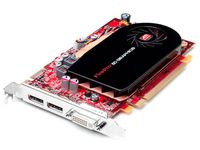AMD Launches 2 New Pro Graphics Cards
AMD announced two new professional graphics accelerators Thursday, and with them a new brand for the company, the ATI FirePro V5700 and V3700. The new brand name, ATI FirePro, tries to demonstrate AMD’s continuing commitment to the professional graphics market and its development.
Of the two new graphics accelerators, the new mid range ATI FirePro V5700 comes with 512 MB of frame buffer memory, dual-link DVI, DisplayPort, HDR rendering, a 30bit display engine, video decode acceleration, and full Blu-ray support that includes picture in picture capabilities and dual stream support. A 30-bit monitor is required for full 30-bit support, for over a billion available colors, providing quite possibly more colors than the human eye can perceive, for maximal color accuracy.
Compared to the previous generation ATI FireGL V5600, with 120 shader processor units, the ATI FirePro V5700 has 320 shader processor units, claiming up to twice the performance with shader intensive applications. AMD further claims better performance with its professional graphics accelerators when compared to their competition at every price point, including its new low entry level professional graphics card, the ATI FirePro V3700. The ATI FirePro V3700 tries to fill a new value segment for CAD professionals migrating from 2D and it has 40 shader processor units, 256 MB of frame buffer memory, two dual-link DVI connectors, and VGA mode support. Both cards support Microsoft DirectX 10.1 and OpenGL 2.0, PCI Express 2.0 interface, and Shader Model 4.1.
The ATI FirePro V3700 should now be available with a MSRP of $99, and the ATI FirePro V5700 is expected to begin shipping in September 2008 with a MSRP of $599. Dell plans to soon carry the ATI FirePro as part of its Dell Precision desktop workstations. Current competition for the entry level ATI FirePro V3700 in the professional segment is Nvidia’s Quadro 370, selling for $119 at CompUSA. Both AMD and Nvidia could soon both be seeing more competition in the professional market though with the expected release of Intel’s Larrabee, a unique discrete solution with GPU capabilities, sometime in 2009 or 2010, which offers great flexibility in its programming and function.
When contacting AMD for comment on Larrabee, they said they feel only time will tell about how successful it will be, but believe it will only be as fast as AMD’s current offerings are today. AMD seems quite proud of its current IGP solutions as well, yet tell us it will have some more big news on the graphics front next week that should underscore AMD’s leadership in graphics.
Get Tom's Hardware's best news and in-depth reviews, straight to your inbox.
-
30 bits per color is the same as 120 bits per pixel. 32 bits per pixel is only 8 bits per color (red, green, blue, alpha). They don't make it very clear, but that's what they mean by 30 bit color, a massive improvement...Reply
-
liemfukliang @Bobucles --> 32 color RGBA @8bit, 30 bit color RGB @10bit. Anyone remember how to edit registry in Windows 95 so that the color diplay is 96 bit? :DReply -
cjl composer77730 bits per color is the same as 120 bits per pixel. 32 bits per pixel is only 8 bits per color (red, green, blue, alpha). They don't make it very clear, but that's what they mean by 30 bit color, a massive improvement...Actually, what they mean is RGB @ 10 bits per sub pixel. So called 32 bit is actually only 8 bit per sub pixel.Reply -
NightLight Reply...that should underscore AMD’s leadership in graphics.
I missed the day when they became the leader in graphics...
Constant driver problems, glitches in every card to date and
generally unstable cards. The only thing they had going were onboard graphics, and I'm talking about the older products, such as the ati rage.
